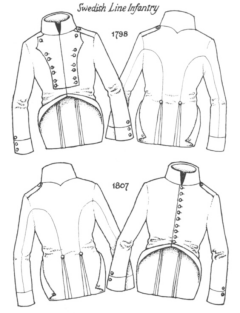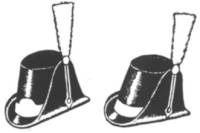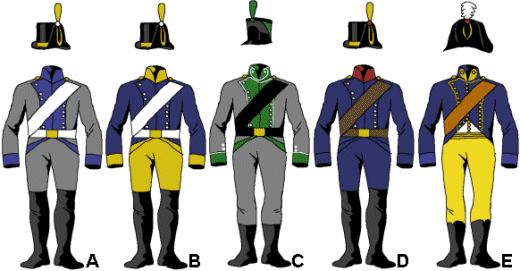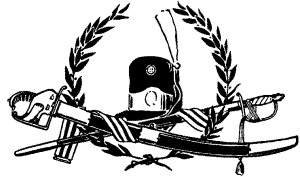Notes on Uniforms
"Knötel stated himself that the Swedes themselves knew little of their own uniform history and I can testify from personal experience that this is, if anything, an understatement."
Whitney B. Young
As the above quote states, the war of 1808-09 is uniformology-hell for the historian. You will have to excuse us for not having all the facts on the table at once, yet work is progressing on the uniformology area and we will soon be able to present you with a rather good picture. Let us begin here. Let us deal with the Swedish uniform of the war of 1808-09.
There has never been such great confusion in the Swedish uniformology as during this war. King Gustav IV Adolf had a mania for uniforms and consant changes had been made to military dress during his reign. I will try to do some notes on uniformology right here though and expand the article as I get on. I have no ambition of covering all details. Please also check out the Uniform plates by Paul Morillon, describing uniforms of the entire Swedish army of the era. The following Additional Notes on Uniforms also emphasise on the uniforms of the infantry, although we shall also touch upon cavalry, navy and artillery.
Historically the Swedish uniform had often been a phenomenon of its own, clearly distinguished from the uniforms of Western Europe. Also, unwilling to follow the Russian examples, Sweden developed its very own uniform culture. This may have been a result of Sweden's geographical position; isolated in the north, between east and west. The Karoliner uniform of Karl XII in the beginning of the 18th century is the best example of this very own Swedish way of thinking.
 For the Finnish and Swedish infantry that went to war during "our period", the uniforms regulations of 1806 were in function. By 1807 a new uniform was introduced for the army; this new one had collar and turnbacks in dark blue, while lapels were discontinued and only one row of buttons ran down the front of the coat. All that distinguished the different units from each other was a small cockade, worn on the front of the hat. This cockade had a cross-symbol, where the different colour combinations on the arms of the cross distinguished the regiment. The new uniform of 1807 is rather unimportant for us though, as most of the regiments fighting in Finland still retained the old uniform of model 1798 or 1802! The new uniform was mainly distributed in Sweden proper, but also to the Swedish-speaking regiments in Finland - such as the Österbotten's Regiment.
For the Finnish and Swedish infantry that went to war during "our period", the uniforms regulations of 1806 were in function. By 1807 a new uniform was introduced for the army; this new one had collar and turnbacks in dark blue, while lapels were discontinued and only one row of buttons ran down the front of the coat. All that distinguished the different units from each other was a small cockade, worn on the front of the hat. This cockade had a cross-symbol, where the different colour combinations on the arms of the cross distinguished the regiment. The new uniform of 1807 is rather unimportant for us though, as most of the regiments fighting in Finland still retained the old uniform of model 1798 or 1802! The new uniform was mainly distributed in Sweden proper, but also to the Swedish-speaking regiments in Finland - such as the Österbotten's Regiment.
In general, the following features of the uniform were common to all Swedish infantry units. The trademark of the Swedish army was the flat-topped black felt hat, with the left brim turned up, and upon that, the plume. A white belt was worn from the left shoulder to the right hip, and a waistbelt, with the short sword attached to the left hip, was worn outside the coat. The bayonet was worn, along with the ammunitions pouch, on the right hip. A brown-coloured knapsack - with three days of rations among other things - with water canteen at the back, was used. Also along with the uniform there was a long coat, "Kapott" in Swedish.
 The following table simplifies the uniform descriptions of some of the infantry regiments that took part in the war of 1808-09. The table is based on an article by Whitney B. Young published in Tradition Magazine in 1969. I have made some additions and proper changes and corrections to the table though. Further, I have left out Swedish regiments that did not take part in the direct military operations. The colour of the piping is shown within brackets in the following manner; (w) white, (y) yellow, (b) blue and (r) red.
The following table simplifies the uniform descriptions of some of the infantry regiments that took part in the war of 1808-09. The table is based on an article by Whitney B. Young published in Tradition Magazine in 1969. I have made some additions and proper changes and corrections to the table though. Further, I have left out Swedish regiments that did not take part in the direct military operations. The colour of the piping is shown within brackets in the following manner; (w) white, (y) yellow, (b) blue and (r) red.
| Regiment |
Coat |
Collar |
Lapels |
Shoulder
Straps |
Cuffs |
Turnbacks |
Buttons |
Breeches |
Hat Band |
| Uppland |
d. blue |
white |
yellow(w) |
yellow(w) |
yellow(w) |
yellow(w) |
brass |
white |
white |
| Västerbotten |
d. blue |
red |
white |
white |
white |
white |
brass |
white |
white |
| Åbo län |
grey |
d. blue |
d. blue |
d. blue |
d. blue |
d. blue |
brass |
grey |
yellow |
| Adlercreutz |
grey |
red(y) |
blue(y) |
blue(y) |
blue(y) |
grey(b) |
brass |
grey |
yellow? |
| Björneborg |
grey |
l. blue |
l. blue |
grey |
l. blue |
l. blue |
brass |
grey |
yellow |
| Kajana batt. |
d. grey |
blue |
blue |
blue |
blue |
blue |
brass |
grey |
yellow |
| Karelska jäg |
green |
green(y) |
green(y) |
green(y) |
green(y) |
white |
brass |
white |
white |
| Nyland |
grey |
blue |
blue |
blue |
blue |
blue |
brass |
grey |
white |
| Nyland jäg |
grey |
grey(b) |
grey(b) |
grey(b) |
grey(b) |
grey |
brass |
grey |
white |
| Österbotten |
d. blue |
yellow |
d. blue |
d. blue |
yellow |
yellow |
brass |
yellow |
yellow |
| Savolax |
l. grey |
grey(y) |
yellow |
yellow |
yellow |
yellow |
brass |
grey |
yellow |
| Savolax jäg |
l. grey |
green(w) |
green(w) |
green(w) |
green(w) |
green |
white |
grey |
yellow |
| Tavastehus |
grey |
d. blue(r) |
d. blue(r) |
d. blue(r) |
d. blue(r) |
d. blue(r) |
brass |
grey |
white |
| Helsinge |
d. blue |
white |
white |
white |
white |
white |
brass |
white |
brass |

A few examples of Swedish regimental uniforms used during the war of 1808-09. These examples display some of the more famous regiments of the war.
A. Björneborg Regiment; possibly the most famous regiment of the war, B. Österbottens Regiment; which was the only Finnish regiment to wear a uniform that looked like the Swedish, C. Savolax Jäger Regiment; which wore a most peculiar hat, D. Finnish artillery Regiment; the artillery was dressed strikingly similar to the infantry and E. Karelian Dragoons.

Back to The art of War
© Göran Frilund 2000-03, All Rights Reserved.
If you've surfed onto this page from outside and there is no menu on the left,
CLICK HERE for the full Website.

 For the Finnish and Swedish infantry that went to war during "our period", the uniforms regulations of 1806 were in function. By 1807 a new uniform was introduced for the army; this new one had collar and turnbacks in dark blue, while lapels were discontinued and only one row of buttons ran down the front of the coat. All that distinguished the different units from each other was a small cockade, worn on the front of the hat. This cockade had a cross-symbol, where the different colour combinations on the arms of the cross distinguished the regiment. The new uniform of 1807 is rather unimportant for us though, as most of the regiments fighting in Finland still retained the old uniform of model 1798 or 1802! The new uniform was mainly distributed in Sweden proper, but also to the Swedish-speaking regiments in Finland - such as the Österbotten's Regiment.
For the Finnish and Swedish infantry that went to war during "our period", the uniforms regulations of 1806 were in function. By 1807 a new uniform was introduced for the army; this new one had collar and turnbacks in dark blue, while lapels were discontinued and only one row of buttons ran down the front of the coat. All that distinguished the different units from each other was a small cockade, worn on the front of the hat. This cockade had a cross-symbol, where the different colour combinations on the arms of the cross distinguished the regiment. The new uniform of 1807 is rather unimportant for us though, as most of the regiments fighting in Finland still retained the old uniform of model 1798 or 1802! The new uniform was mainly distributed in Sweden proper, but also to the Swedish-speaking regiments in Finland - such as the Österbotten's Regiment.  The following table simplifies the uniform descriptions of some of the infantry regiments that took part in the war of 1808-09. The table is based on an article by Whitney B. Young published in Tradition Magazine in 1969. I have made some additions and proper changes and corrections to the table though. Further, I have left out Swedish regiments that did not take part in the direct military operations. The colour of the piping is shown within brackets in the following manner; (w) white, (y) yellow, (b) blue and (r) red.
The following table simplifies the uniform descriptions of some of the infantry regiments that took part in the war of 1808-09. The table is based on an article by Whitney B. Young published in Tradition Magazine in 1969. I have made some additions and proper changes and corrections to the table though. Further, I have left out Swedish regiments that did not take part in the direct military operations. The colour of the piping is shown within brackets in the following manner; (w) white, (y) yellow, (b) blue and (r) red.
